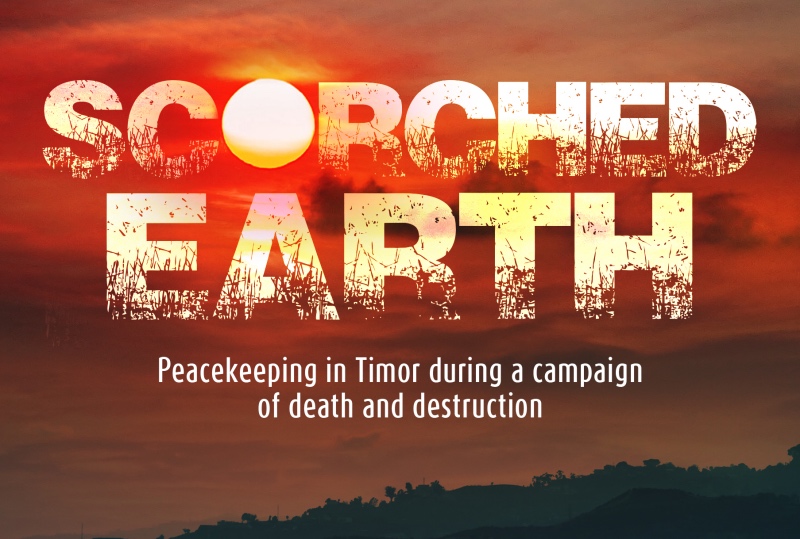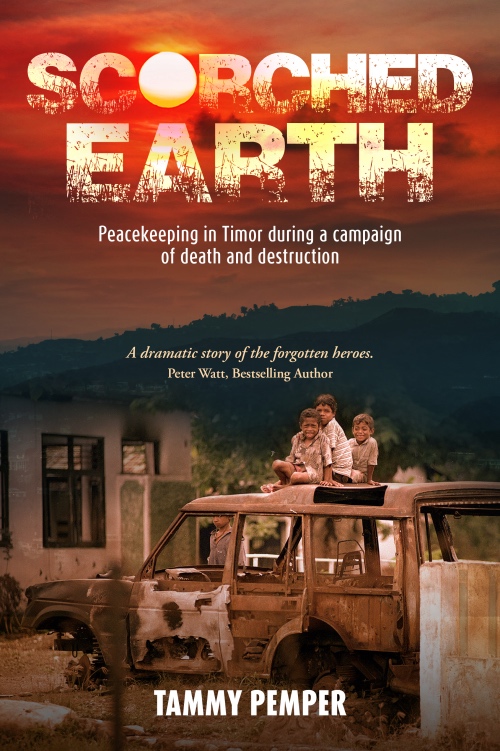
DAVID ADAMS reads ‘Scorched Earth’, an account of one peace-keeper’s experiences as East Timor moved towards independence…
Tammy Pemper
Scorched Earth: Peacekeeping in Timor during a campaign of death and destruction
Big Sky Publishing, Newport, NSW, Australia, 2019
ISBN-13: 978-1922265432

“Scorched Earth gives a ground level view of the events leading up to the INTERFET deployment in 1999, conveying a strong sense of the confusion, uncertainty and, yes, impotence which plagued the peace-keeping mission Watt was a part of. And yet it also shows the resilence of spirit of the East Timorese; how they stood up to be counted despite the sustained campaign of terror – ‘scorched Earth’ – waged against them (and the cost it came with for so many), so their families could have a different future.”
In August, 1999, Peter Watt, a senior-sergeant with the Australian Federal Police, joined the UN peace-keeping force in East Timor as the land which was then part of Indonesia held a referendum on whether to be an independent nation or an autonomous territory of Indonesia. Set over a couple of weeks in August and September of that year, this is an account of his experiences during that tumultuous period.
Scorched Earth is written in the first person by Tammy Pemper, an Australian who has worked with the UN, Australian Federal Police and US Peace Corps and who spent five years in in East Timor collecting stories and first-hand accounts for the book. Through Watt’s eyes, it tells of the frustration, anger and horror peacekeepers like him felt as they went to observe the referendum vote to ensure it was conducted fairly and found themselves confronted with widespread violence which they were powerless to do anything about.
A former Portuguese colony, in 1975 East Timor was invaded and occupied by the Indonesian military. Decades of conflict between the Indonesian forces and their supporters and separatist groups followed before, in 1999, a UN supported agreement between Indonesia and Portugal led to a referendum on its future.
The result – despite intimidation tactics employed by pro-Indonesian militia (described in Pemper’s book) – came back in clear support of independence. And while a cause of celebration for many East Timorese, it sparked a wave of violence and destruction which led the deployment of an Australian-led multi-national peacekeeping force known as INTERFET.
It was the start of a process which eventually saw, on 20th May, 2002, the new nation of East Timor recognised as independent by the UN and former freedom fighter Xanana Gusmão sworn in as the country’s first President. It was officially renamed Timor-Leste, in the Portuguese language, soon after.
These events came with a high cost – estimates suggest that more than 200,000 people were killed in the years after the invasion (most of them in the years immediately after) – with thousands more tortured (Pemper calls it a genocide and says statistics show it to be a greater per-capita slaughter than any genocide since the Holocaust). It’s estimated a further 1,500 died in the violence following the independence referendum while some 300,000 were forced into West Timor as refugees.
Pemper’s book, which is concerned with events surrounding the initial referendum result, follows Peter as he’s deployed to a polling station in the town of Gleno where he witnesses firsthand the violence which took place on polling day before he and the other peacekeepers were eventually ordered back to the UN’s HQ in the capital of Dili as the land spiralled into chaos.
This is Watt’s’ story but as well as gaining insights into his experiences, we’re also given access into the attitudes of other peacekeepers and to stories of people like Juvinal and Nikolai, local men who worked for the UN, and Esmeralda, a Catholic nun who repeatedly put her own life on the line in standing up for the East Timorese people.
In giving a ground level view of the events leading up to the INTERFET deployment in 1999, Scorched Earth conveys a strong sense of the confusion, uncertainty and, yes, impotence which Watt and other peace-keepers felt as well as the vividly painting a picture of the horrors the East Timorese faced in their struggle for independence.
But it also shows the resilence of spirit among the East Timorese and how, often at a cost to their own lives, they stood up to be counted despite the sustained campaign of terror – “scorched Earth” – waged against them, so they and their families could have a different future.
Pemper, who married Watt in 2003, is donating all profits from the book to the people of Timor-Leste.





